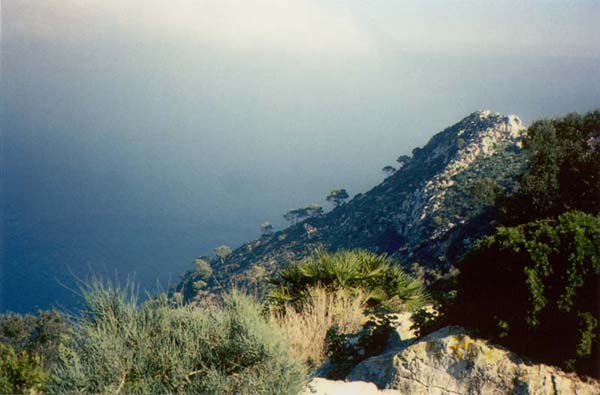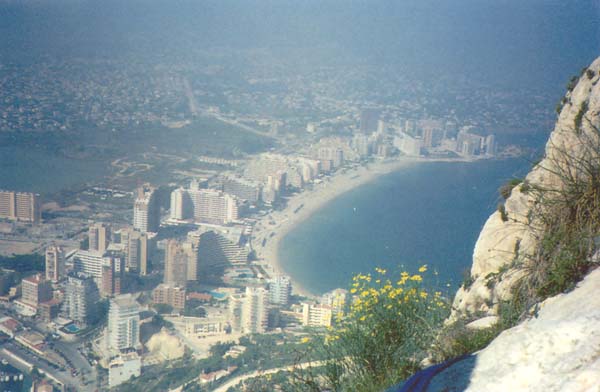Background

The Peñon d'Ifach seen from the drive into Calpe
We came to Calpe on Costa Blanca, Spain to climb the Peñon d'Ifach. Our friend Pauline sent us her trip report on Spain and her climb on the Peñon caught our eyes. Sure, all the climbing in Spain sounded good, but to climb a rock with three sides surrounded by the Mediterranean sounded pretty spectacular.
The climb would take all day for us and was expected to be on the hot side so we packed plenty of water and some nice cheese and other snacks that we bought the night before at the supermarket. We also packed six rolls of film, just in case. If there ever was a climb to bring a camera on, this was it. We also brought just the page from the rockfax guidebook rather than the whole book to save on weight.
Our Route
The Approach
To get to the climb, we followed the signs to the Peñon, and parked in a large parking area at the edge of the ocean. There were several restaraunts there that are good for a Mediterranean seafood paella dinner after the climb.
We walked to the end of the parking lot and followed a sidewalk to its end. There was a blue outhouse at that point. We walked behind the wall and scrambled up the eroded slope to the left side of the rock to the base of our route. There is an arrow spray painted on the rock indicatng that we were there. We did not see the arrow until after we roped up, but it is there.
Pitch 1
A dirty, loose pitch, without good pro until you get up a bit. Head up to the big bush. When you get to it, go underneath it to the left, then angle up and left. Keep going until you reach a four-bolt anchor on a big white slab. (To the right of this anchor are bolts belonging to Polvos Mágicos. It is be possible to take this line up to the next belay, rather than following the somewhat uneventful Pitch 2. This would be a 6a+ (our 5.10c), and the guidebook describes it as "slippery" and "sustained".)
Pitch 2
Walk left along ledge past bushes until you arrive at a right-leaning ramp. Ascend the ramp, traversing right until directly above your belayer. (It should be possible to combine this pitch with our "3a".)
Pitch 3a*
* Pitch 3a and 3b are Pitch 3 in the guidebook
Traverse right along the ledge to two large cracks forming a "V" in the corner. On the way you will pass the 6b+ and 6b (5.11a and 5.10d) cracks belonging to Sensacion de vivir and Pilar López de Sancho.
Pitch 3b
Ascend the right-hand component of the V. It's rated 5.10, but it's short, and although somewhat awkward and quite polished, it is easier than a Gunks 10. There are slings around chockstones in the crack, and the belay is at the base of the slab above.
By splitting Pitch 3 up as we had done, it enables the leader to climb the hardest pitch with the belayer directly below, thus minimizing the chance of rope drag.
Pitch 4a

At this point, I was reminded of David Roberts' book title "Moments of Doubt". Above the belay is an outcrop. You're supposed to "climb left onto a slab to a bush belay". We headed for the outcrop, which seemed like a good idea, but evidently went too high above it and ended up at two odd-looking pitons. Apparently the left you are supposed to take is at some point below. We could see the line of bolts of Valencianos not far away, but by the time we had arrived at this belay, it seemed a bit sketchy to traverse back to where we were supposed to be.
Instead, we decided to link up with Polvos Mágicos, a route to the immediate right of Valencia, and now about the same rating. There is also a thin crack leading directly from the belay pitons to the next chain/bolt belay above. It looked good but as we didn't know its rating nor if it would take pro, we instead chose the dihedral and crack system to the right, which is the actual route of Polvos Mágicos. On the way, we passed a fossil feature in the rock.
Pitch 4b
Followed the dihedral/crack system as it continued up and arched left. A move left out of the crack places you at the aforementioned chain/bolt belay.
Pitch 5
This is a long pitch; a bit lonely if no one else is on the cliff. We were glad to have walkie-talkies, as it became a bit breezy and would have been hard to communicate (a party on a difficult climb far to our right were having serious communication problems on account of the wind). There is occasional fixed pro, and plenty of places for trad gear.
The second half of this pitch is significantly better than the first. Topping out on the ridge line is truly amazing: the Mediterranean is behind you and the city of Calpe and it's beaches stretch out below you on the other side of the ridge. There's an old two-bolt anchor in what looks to simply be a big boulder; backup pro is advised.
Pitch 6
Now the climb leads to the other side of the Peñon. Traverse left about twenty feet until you come to a crack in a slab that has a sling about twelve feet up. Climb the crack (5.7), past the sling until you come to a spike in the rock. Apparently some belay at this spike, but about ten feet right is a two-bolt anchor, with a third a bit farther right. Belaying here is much more comfortable.
Pitch 7
This is another long pitch, crossing easy, blocky ground. In general, you just head for the top. We angled left through a vegetated notch and arrived at the base of a very long, cleaner notch. To get here used most of our 60m rope, but there's plenty of other places to belay.
Pitch 8
Climb the notch (ca. 30 ft) and you will arrive at the top of the climb. The actual peak of the Peñon is to your left (as you stand with your back to Calpe) about a hundred meters or so.
The Descent
Looking down the backside of the Peñon, the descent trail can be discerned. There should be lots of people hiking on the trail. There are some places that seemed a bit dangerous since one slip could send you down 1000 feet into the ocean, but no one else seemed to mind. It's a nice walk down, but takes quite a while.

The hiking trail down the back
Getting There
We flew to Spain via London and landed in Barcelona with enough time to catch a short flight to Valencia. Our other option would have been to rent a car from Barcelona and drive the coast to Calpe (about 5 hours) but after flying all day, we decided the short drive to Calpe from Valencia was a bit more manageable. The round trip flight from Barcelona to Valencia was about $150. Extravagant, but helpful with time.
From Valencia, we rented a car and first drove the wrong way to Calpe and had to make a U turn at a toll booth to change direction. Once on our way, the route was very easy and took maybe 1-2 hours.
Where to Stay
Pauline gave us the email address of Ian in Calpe who rents out apartments on a weekly basis. He and his wife Rosemary are originally from England, but live in Calpe now. This made it very easy for us. We made our reservations by email, called when we arrived in Calpe, and they came and got us and showed us where to park our rental car.
The apartment was very nice, with a kitchen, living room with a dining area, a bedroom, and a bathroom. There was also a pool but we did not indulge. To reserve an apartment email Ian and Rosemary at ianm@arrakis.es
Guide Books
Costa Blanca Mallorca El Chorro - Rockfax guidebook.




